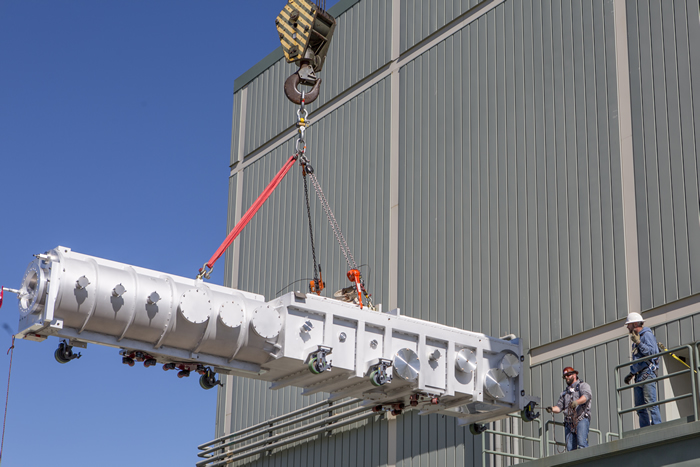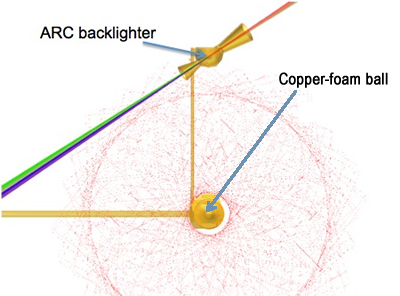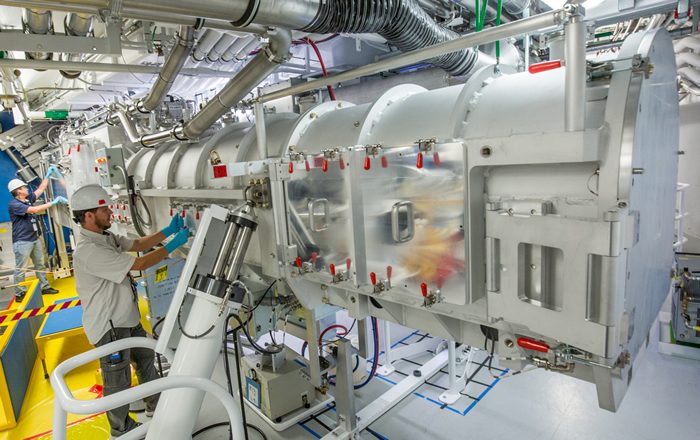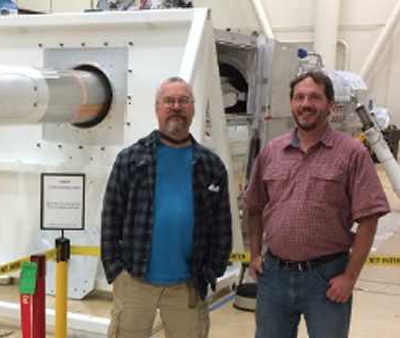Efficiency Improvements - 2017
February
NIF’s Dual-Purpose Positioner Is Proving Its Worth
Second Dual-purpose Positioner Readied for Action
NIF’s second target and diagnostic manipulator, known as TanDM 124, was moved into position in the Target Bay on Feb. 28. The TanDM positioners were designed to enhance NIF’s capabilities and efficiency by improving the facility’s ability to alternate between cryogenic and warm targets and by increasing the capacity to diagnose experiments.
 TanDM 124 is lifted onto the NIF loading dock so it can be moved into the Target Bay.
TanDM 124 is lifted onto the NIF loading dock so it can be moved into the Target Bay. The first TanDM, installed last year, has been dedicated to inserting targets. TanDM 124 will focus on diagnostic manipulation. The ability to deploy more diagnostics enables NIF to capture more data on a single experiment, improving the facility’s productivity. Alternately, the new TanDM can be used to reduce the frequency with which diagnostics must be exchanged to support an experimental configuration. The new capability was developed with the help of and to support NIF’s Stockpile Stewardship Program users.
The TanDMs were designed with the efficiency of NIF’s workers in mind: a diagnostic instrument can be exchanged in about one-fourth the time of TanDM’s predecessor machine. And the large and numerous access ports allow NIF’s Operations Team to quickly exchange consumables or x-ray imaging components between shots.
The TANDMs also are proving to be extremely stable and reliable—they can hold a target or a diagnostic in the center of the Target Chamber in position to within less than 50 microns, smaller than the diameter of a human hair.
When connections and activation are completed on TanDM 124, NIF will have two cryogenic target positioners, three dedicated diagnostic positioners, and the two TanDMs, which can insert either non-cryo targets or diagnostics.
NIF’s Dual-Purpose Positioner Is Proving Its Worth
While multitasking may be easy for some people (and perhaps hard for others), it can be a particular challenge for the highly specialized equipment used to carry out experiments on NIF. But TanDM, NIF’s new Target and Diagnostic Manipulator, is designed to do just that. To date it is proving itself more than up to the job of performing as a target positioner for NIF shots. During the coming months it also will be commissioned for positioning diagnostics.
Installed in June of last year, TanDM is now a routine part of many NIF experiments (see “Dual-purpose Positioner Gets Its Baptism of Fire”). And in December, TanDM was successfully used for the first time to hold a target for an Advanced Radiographic Capability (ARC) shot. ARC is NIF’s petawatt-class laser system, designed to produce brighter, more penetrating, higher-energy x rays than is possible with conventional radiographic techniques.
 Diagram of the TanDM target used in the Dec. 7 ARC experiment, which used ARC radiography to study complex hydrodynamics.
Diagram of the TanDM target used in the Dec. 7 ARC experiment, which used ARC radiography to study complex hydrodynamics. “ARC has tighter alignment or stability requirements than most NIF shots do,” said NIF Alignment Operations Manager Shannon Ayers, “and the question was whether or not TanDM was stable enough to hold an ARC shot target.
“We got good data,” she said, “which suggests that TanDM may meet the tight tolerances, but stability tests are ongoing. ARC shots require the use of two separate target positioners, one for the active target, which is a CCD (charge-coupled device) used to align the ARC beams, and one for the shot target. We currently put the active target on TarPos (a standard NIF target positioner) and the ARC shot target on CryoTarPos (the cryogenic target positioner). In order to dedicate the CryoTarPos for layered experiments, it is desirable to use TanDM for either the active target or the shot target.”
TanDM was designed to enhance NIF’s efficiency by allowing the CryoTarPos to remain dedicated to growing cryogenically cooled target layers, while the TanDM and the TarPos alternate in positioning targets for room-temperature and cryogenic target experiments. The instrument is able to transition from a diagnostic inserter into a target positioner in less than four hours. The design is expected to support diagnostic exchanges in less than one hour and snout exchanges in less than 20 minutes. TanDM is thus an important element in achieving the productivity goals established in the 2014 “120-Day Study” of NIF efficiency improvements, while increasing the rate of integrated experiments with cryogenic fuel layers.
 Target Area operators prepare the TanDM for a NIF shot. The 9,000-kilogram (20,000-pound) mechanism is about 8.5 meters long, with a boom that can extend about 6.75 meters. Credit: Jason Laurea
Target Area operators prepare the TanDM for a NIF shot. The 9,000-kilogram (20,000-pound) mechanism is about 8.5 meters long, with a boom that can extend about 6.75 meters. Credit: Jason Laurea Work on the TanDM concept began in November of 2014. Requirements for its operation and the design were established in early 2015, and the instrument was commissioned for NIF shots in September of last year. A second TanDM, which will initially focus on diagnostic manipulation, is scheduled for installation in March of this year.
A major factor in TanDM’s success to date has been the work of software engineers Lyle Beaulac, Mikhail Fedorov, and Rick Wilson, and LLNL Summer Scholar Sara Woods, who were responsible for developing the controls software for the positioner.
 NIF software engineers Lyle Beaulac (left) and Rick Wilson in front of the TanDM positioner in the off-line facility where the TanDM was assembled.
NIF software engineers Lyle Beaulac (left) and Rick Wilson in front of the TanDM positioner in the off-line facility where the TanDM was assembled. Collaboration between the NIF Computing (NIFC) Division software engineers and the TanDM engineering and commissioning team (Ayers, Terry Malsbury, Tom Kohut, and Arlen Rowe) was crucial during all phases of the project. The NIFC engineers engaged early with the TanDM design team to provide advice on controls selection and to ensure the maximal reuse of existing hardware and software components, thus accelerating the delivery schedule and minimizing commissioning risk.
The NIFC team assisted in fine-tuning the assembled TanDM configuration in an offline facility to prepare for its operational qualification and deployment, reducing operational impact on NIF. After the positioner was installed in the NIF Target Bay, the team provided around-the-clock support during the online commissioning activities; many of these activities were performed off-hours to work around shot operations.
Also playing an important role in recent months was physicist David Martinez, who helped develop the stability tests and analysis that prepared TanDM for the ARC shots (see “Aligning the Target Positioners”).
“In general, TanDM functions quite well and it’s almost seamless,” Ayers said. “The shot operators like using TanDM as a target positioner because it’s well characterized and the alignments go faster, in their opinion, when they’re using TanDM.”



